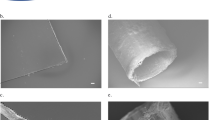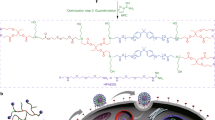Abstract
The successful development of efficient and safe gene delivery vectors continues to be a major obstacle to gene delivery in stem cells. In this study, we have developed an elastin-like polypeptide (ELP)-mediated adeno-associated virus (AAV) delivery system for transducing fibroblasts and human neural stem cells (hNSCs). AAVs have significant promise as therapeutic vectors because of their safety and potential for use in gene targeting in stem cell research. ELP has been recently employed as a biologically inspired ‘smart’ biomaterial that exhibits an inverse temperature phase transition, thereby demonstrating promise as a novel drug carrier. The ELP that was investigated in this study was composed of a repetitive penta-peptide with [Val-Pro-Gly-Val-Gly]. A novel AAV variant, AAV r3.45, which was previously engineered by directed evolution to enhance transduction in rat NSCs, was nonspecifically immobilized onto ELPs that were adsorbed beforehand on a tissue culture polystyrene surface (TCPS). The presence of different ELP quantities on the TCPS led to variations in surface morphology, roughness and wettability, which were ultimately key factors in the modulation of cellular transduction. Importantly, with substantially reduced viral quantities compared with bolus delivery, ELP-mediated AAV delivery significantly enhanced delivery efficiency in fibroblasts and hNSCs, which have great potential for use in tissue engineering applications and neurodegenerative disorder treatments, respectively. The enhancement of cellular transduction in stem cells, as well as the feasibility of ELPs for utilization in three-dimensional scaffolds, will contribute to the advancement of gene therapy for stem cell research and tissue regenerative medicine.
This is a preview of subscription content, access via your institution
Access options
Subscribe to this journal
Receive 12 print issues and online access
$259.00 per year
only $21.58 per issue
Buy this article
- Purchase on Springer Link
- Instant access to full article PDF
Prices may be subject to local taxes which are calculated during checkout





Similar content being viewed by others
References
Maitra A, Arking DE, Shivapurkar N, Ikeda M, Stastny V, Kassauei K et al. Genomic alterations in cultured human embryonic stem cells. Nat Genet 2005; 37: 1099–1103.
Kim JH, Auerbach JM, Rodriguez-Gomez JA, Velasco I, Gavin D, Lumelsky N et al. Dopamine neurons derived from embryonic stem cells function in an animal model of Parkinson's disease. Nature 2002; 418: 50–56.
Lai K, Kaspar BK, Gage FH, Schaffer DV . Sonic hedgehog regulates adult neural progenitor proliferation in vitro and in vivo. Nat Neurosci 2003; 6: 21–27.
Kaplitt MG, Feigin A, Tang C, Fitzsimons HL, Mattis P, Lawlor PA et al. Safety and tolerability of gene therapy with an adeno-associated virus (AAV) borne GAD gene for Parkinson's disease: an open label, phase I trial. Lancet 2007; 369: 2097–2105.
Kay MA, Manno CS, Ragni MV, Larson PJ, Couto LB, McClelland A et al. Evidence for gene transfer and expression of factor IX in haemophilia B patients treated with an AAV vector. Nat Genet 2000; 24: 257–261.
Bainbridge JW, Smith AJ, Barker SS, Robbie S, Henderson R, Balaggan K et al. Effect of gene therapy on visual function in Leber's congenital amaurosis. N Engl J Med 2008; 358: 2231–2239.
Maguire AM, Simonelli F, Pierce EA, Pugh Jr EN, Mingozzi F, Bennicelli J et al. Safety and efficacy of gene transfer for Leber's congenital amaurosis. N Engl J Med 2008; 358: 2240–2248.
Fisher KJ, Jooss K, Alston J, Yang Y, Haecker SE, High K et al. Recombinant adeno-associated virus for muscle directed gene therapy. Nat Med 1997; 3: 306–312.
Kaplitt MG, Leone P, Samulski RJ, Xiao X, Pfaff DW, O'Malley KL et al. Long-term gene expression and phenotypic correction using adeno-associated virus vectors in the mammalian brain. Nat Genet 1994; 8: 148–154.
Flannery JG, Zolotukhin S, Vaquero MI, LaVail MM, Muzyczka N, Hauswirth WW . Efficient photoreceptor-targeted gene expression in vivo by recombinant adeno-associated virus. Proc Natl Acad Sci USA 1997; 94: 6916–6921.
Russell DW, Hirata RK . Human gene targeting by viral vectors. Nat Genet 1998; 18: 325–330.
Jang JH, Koerber JT, Kim JS, Asuri P, Vazin T, Bartel M et al. An evolved adeno-associated viral variant enhances gene delivery and gene targeting in neural stem cells. Mol Ther 2011; 19: 667–675.
Hughes SM, Moussavi-Harami F, Sauter SL, Davidson BL . Viral-mediated gene transfer to mouse primary neural progenitor cells. Mol Ther 2002; 5: 16–24.
Smith-Arica JR, Thomson AJ, Ansell R, Chiorini J, Davidson B, McWhir J . Infection efficiency of human and mouse embryonic stem cells using adenoviral and adeno-associated viral vectors. Cloning Stem Cells 2003; 5: 51–62.
Jang JH, Houchin TL, Shea LD . Gene delivery from polymer scaffolds for tissue engineering. Expert Rev Med Devices 2004; 1: 127–138.
Jang JH, Koerber JT, Gujraty K, Bethi SR, Kane RS, Schaffer DV . Surface immobilization of hexa-histidine-tagged adeno-associated viral vectors for localized gene delivery. Gene Therapy 2010; 17: 1384–1389.
Beer SJ, Matthews CB, Stein CS, Ross BD, Hilfinger JM, Davidson BL . Poly (lactic-glycolic) acid copolymer encapsulation of recombinant adenovirus reduces immunogenicity in vivo. Gene Therapy 1998; 5: 740–746.
Schek RM, Hollister SJ, Krebsbach PH . Delivery and protection of adenoviruses using biocompatible hydrogels for localized gene therapy. Mol Ther 2004; 9: 130–138.
Bidwell III GL, Fokt I, Priebe W, Raucher D . Development of elastin-like polypeptide for thermally targeted delivery of doxorubicin. Biochem Pharmacol 2007; 73: 620–631.
Dreher MR, Raucher D, Balu N, Michael Colvin O, Ludeman SM, Chilkoti A . Evaluation of an elastin-like polypeptide-doxorubicin conjugate for cancer therapy. J Control Release 2003; 91: 31–43.
Na K, Jung J, Lee J, Hyun J . Thermoresponsive pore structure of biopolymer microspheres for a smart drug carrier. Langmuir 2010; 26: 11165–11169.
Urry DW, Trapane TL, Prasad KU . Phase-structure transitions of the elastin polypentapeptide-water system within the framework of composition-temperature studies. Biopolymers 1985; 24: 2345–2356.
Meyer DE, Shin BC, Kong GA, Dewhirst MW, Chilkoti A . Drug targeting using thermally responsive polymers and local hyperthermia. J Control Release 2001; 74: 213–224.
Meyer DE, Kong GA, Dewhirst MW, Zalutsky MR, Chilkoti A . Targeting a genetically engineered elastin-like polypeptide to solid tumors by local hyperthermia. Cancer Res 2001; 61: 1548–1554.
Betre H, Liu W, Zalutsky MR, Chilkoti A, Kraus VB, Setton LA . A thermally responsive biopolymer for intra-articular drug delivery. J Control Release 2006; 115: 175–182.
Girotti A, Reguera J, Rodriguez-Cabello JC, Arias FJ, Alonso M, Matestera A . Design and bioproduction of a recombinant multi(bio)functional elastin-like protein polymer containing cell adhesion sequences for tissue engineering purposes. J Mater Sci Mater Med 2004; 15: 479–484.
Betre H, Setton LA, Meyer DE, Chilkoti A . Characterization of a genetically engineered elastin-like polypeptide for cartilaginous tissue repair. Biomacromolecules 2002; 3: 910–916.
Temple S . The development of neural stem cells. Nature 2001; 414: 112–117.
Rabe M, Verdes D, Seeger S . Understanding protein adsorption phenomena at solid surfaces. Adv Colloid Interface Sci 2011; 162: 87–106.
Takeda N, Kato M, Taniguchi Y . Pressure- and thermally-induced reversible changes in the secondary structure of ribonuclease A studied by FT-IR spectroscopy. Biochemistry 1995; 34: 5980–5987.
Arima Y, Iwata H . Effect of wettability and surface functional groups on protein adsorption and cell adhesion using well-defined mixed self-assembled monolayers. Biomaterials 2007; 28: 3074–3082.
Ganesan R, Eigenbrot C, Kirchhofer D . Structural and mechanistic insight into how antibodies inhibit serine proteases. Biochem J 2010; 430: 179–189.
Tao S, Young C, Redenti S, Zhang Y, Klassen H, Desai T et al. Survival, migration and differentiation of retinal progenitor cells transplanted on micro-machined poly(methyl methacrylate) scaffolds to the subretinal space. Lab Chip 2007; 7: 695–701.
Bengali Z, Pannier AK, Segura T, Anderson BC, Jang JH, Mustoe TA et al. Gene delivery through cell culture substrate adsorbed DNA complexes. Biotechnol Bioeng 2005; 90: 290–302.
Norde W, Lyklema J . Why proteins prefer interfaces. J Biomater Sci Polym Ed 1991; 2: 183–202.
Rose JA, Maizel Jr JV, Inman JK, Shatkin AJ . Structural proteins of adenovirus-associated viruses. J Virol 1971; 8: 766–770.
Jang JH, Bengali Z, Houchin TL, Shea LD . Surface adsorption of DNA to tissue engineering scaffolds for efficient gene delivery. J Biomed Mater Res A 2006; 77: 50–58.
Shen H, Tan J, Saltzman WM . Surface-mediated gene transfer from nanocomposites of controlled texture. Nat Mater 2004; 3: 569–574.
Shin S, Tuinstra HM, Salvay DM, Shea LD . Phosphatidylserine immobilization of lentivirus for localized gene transfer. Biomaterials 2010; 31: 4353–4359.
Shin S, Shea LD . Lentivirus immobilization to nanoparticles for enhanced and localized delivery from hydrogels. Mol Ther 2010; 18: 700–706.
Kim HT, Kim IS, Lee IS, Lee JP, Snyder EY, Park KI . Human neurospheres derived from the fetal central nervous system are regionally and temporally specified but are not committed. Exp Neurol 2006; 199: 222–235.
Maheshri N, Koerber JT, Kaspar BK, Schaffer DV . Directed evolution of adeno-associated virus yields enhanced gene delivery vectors. Nat Biotechnol 2006; 24: 198–204.
Koerber JT, Maheshri N, Kaspar BK, Schaffer DV . Construction of diverse adeno-associated viral libraries for directed evolution of enhanced gene delivery vehicles. Nat Protoc 2006; 1: 701–706.
Zolotukhin S, Byrne BJ, Mason E, Zolotukhin I, Potter M, Chesnut K et al. Recombinant adeno-associated virus purification using novel methods improves infectious titer and yield. Gene Therapy 1999; 6: 973–985.
Meyer DE, Chilkoti A . Genetically encoded synthesis of protein-based polymers with precisely specified molecular weight and sequence by recursive directional ligation: examples from the elastin-like polypeptide system. Biomacromolecules 2002; 3: 357–367.
Acknowledgements
This work was supported by a National Research Foundation (NRF) grant funded by the Korean government (MEST) through the Active Polymer Center for Pattern Integration (No. R11-2007-050-00000-0) and NRF-20100015515. Additionally, this work was supported by the Human Resources Development of the Korea Institute of Energy Technology Evaluation and Planning (KETEP) grant funded by the Korea government Ministry of Knowledge Economy (No. 20104010100500). KIP was supported by the Stem Cell Research Center, Healthcare Technology R&D Project (A091159), and National Research Foundation of Korea grant (2010-0020289) by Korean Government.
Author information
Authors and Affiliations
Corresponding authors
Ethics declarations
Competing interests
The authors declare no conflict of interest.
Rights and permissions
About this article
Cite this article
Kim, JS., Chu, H., Park, K. et al. Elastin-like polypeptide matrices for enhancing adeno-associated virus-mediated gene delivery to human neural stem cells. Gene Ther 19, 329–337 (2012). https://doi.org/10.1038/gt.2011.84
Received:
Revised:
Accepted:
Published:
Issue Date:
DOI: https://doi.org/10.1038/gt.2011.84
Keywords
This article is cited by
-
Application of short hydrophobic elastin-like polypeptides for expression and purification of active proteins
3 Biotech (2020)
-
Recombinant elastin-based nanoparticles for targeted gene therapy
Gene Therapy (2017)
-
Peptide-Based and Polypeptide-Based Gene Delivery Systems
Topics in Current Chemistry (2017)
-
Single-step concentration and purification of adenoviruses by coxsackievirus-adenovirus receptor-binding capture and elastin-like polypeptide-mediated precipitation
Archives of Virology (2016)
-
Electrospun nanofibers as versatile interfaces for efficient gene delivery
Journal of Biological Engineering (2014)



